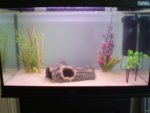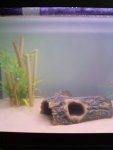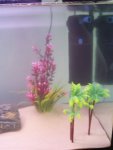Gim
Member
Hi, i'm new here just wanted to get some information about how best to set up my new tank. I'm keeping an eye on the for sale section here but if anyone has some juve leuristic axies (pref with no freckles) somewhere close to the Reading area please get in touch.
I want to make sure everything is right before I buy my new baby so sorry for all the following questions.
1) Am I right in getting the washed sand and ornaments etc into the tank and start them running with my fluval 2+ for a couple of weeks.. will this be enough dechlorination on its own or would you still recomend using a store bought chemical? I keep a tropical fish tank which I moved to my new house last weekend and therefore ended up doing a 40% (40ishL) water change on, would adding some of this water to my clean tank help get the chemistry balance right?
2) im actually a water chemistry analyst as a job so have good access to testing facilities. are the nutrient analyses i want to run, ammonia as nh3, nitrite as no2 and chloride? is it also a good idea to run a pH analysis?
I will post the results on here to check if they are ok.
3) For those who use a fluval 2+ do you use the carbon sponge as well as the white poly sponges or do you use the fine particle white sponges?
4) In terms of plants is there a good balance between real and fake, do real give much benefit other than water chemistry.
5) In my fish tank I use frozen blood worm blocks (1.5cm squared ish) which at the moment I just drop a whole block in and the big kissing gourami munches 95% of. What is a good meal portion for 1 axolotl, also I find that the worm blocks float for 5 or so mins in the fish tank, how does everyone else get round this to avoid mess?
Thanks so much for any help you can give I will post pictures etc when my sand arrives this week and i get the tank cycling
Gemma
I want to make sure everything is right before I buy my new baby so sorry for all the following questions.
1) Am I right in getting the washed sand and ornaments etc into the tank and start them running with my fluval 2+ for a couple of weeks.. will this be enough dechlorination on its own or would you still recomend using a store bought chemical? I keep a tropical fish tank which I moved to my new house last weekend and therefore ended up doing a 40% (40ishL) water change on, would adding some of this water to my clean tank help get the chemistry balance right?
2) im actually a water chemistry analyst as a job so have good access to testing facilities. are the nutrient analyses i want to run, ammonia as nh3, nitrite as no2 and chloride? is it also a good idea to run a pH analysis?
I will post the results on here to check if they are ok.
3) For those who use a fluval 2+ do you use the carbon sponge as well as the white poly sponges or do you use the fine particle white sponges?
4) In terms of plants is there a good balance between real and fake, do real give much benefit other than water chemistry.
5) In my fish tank I use frozen blood worm blocks (1.5cm squared ish) which at the moment I just drop a whole block in and the big kissing gourami munches 95% of. What is a good meal portion for 1 axolotl, also I find that the worm blocks float for 5 or so mins in the fish tank, how does everyone else get round this to avoid mess?
Thanks so much for any help you can give I will post pictures etc when my sand arrives this week and i get the tank cycling
Gemma




